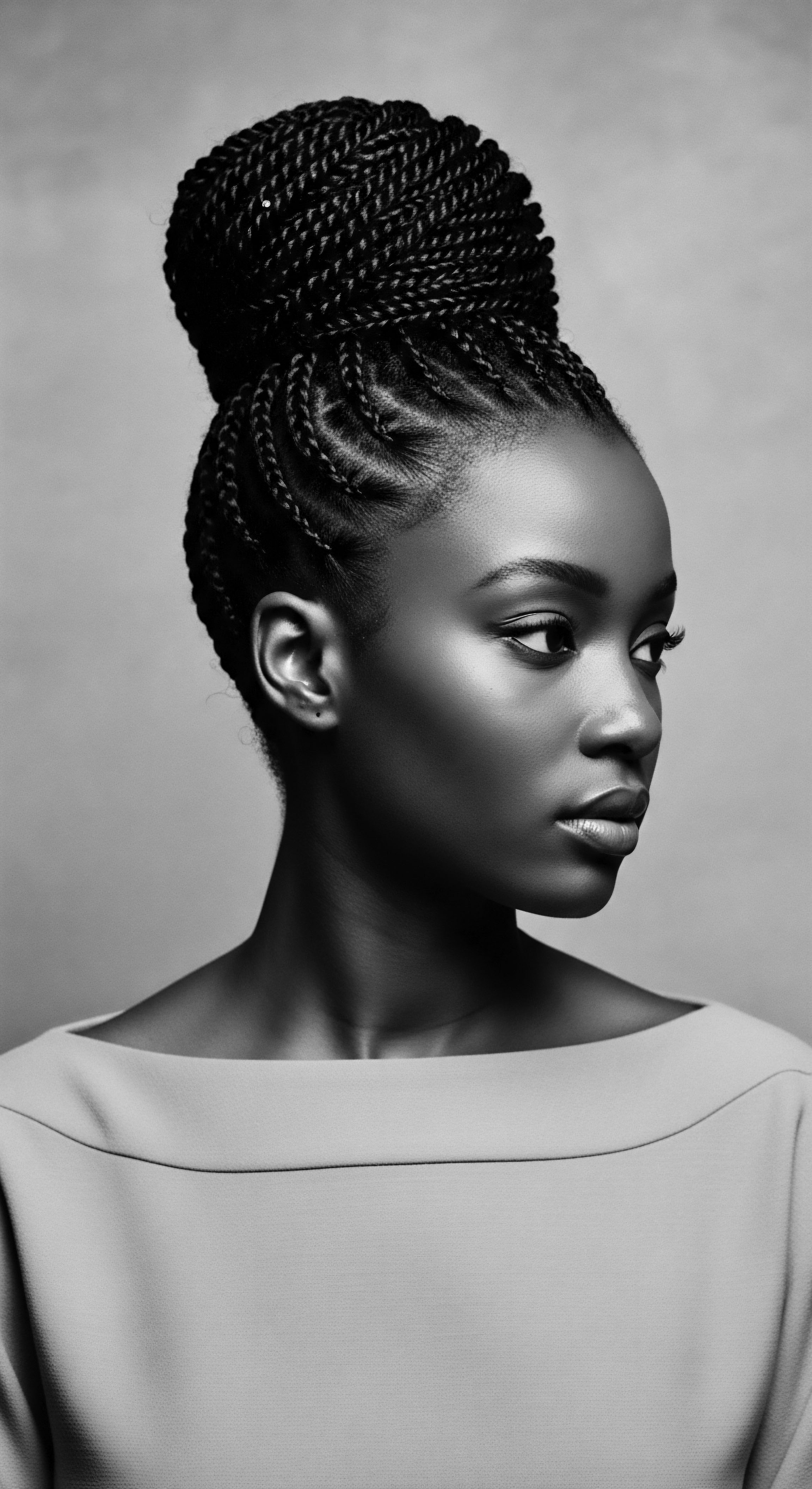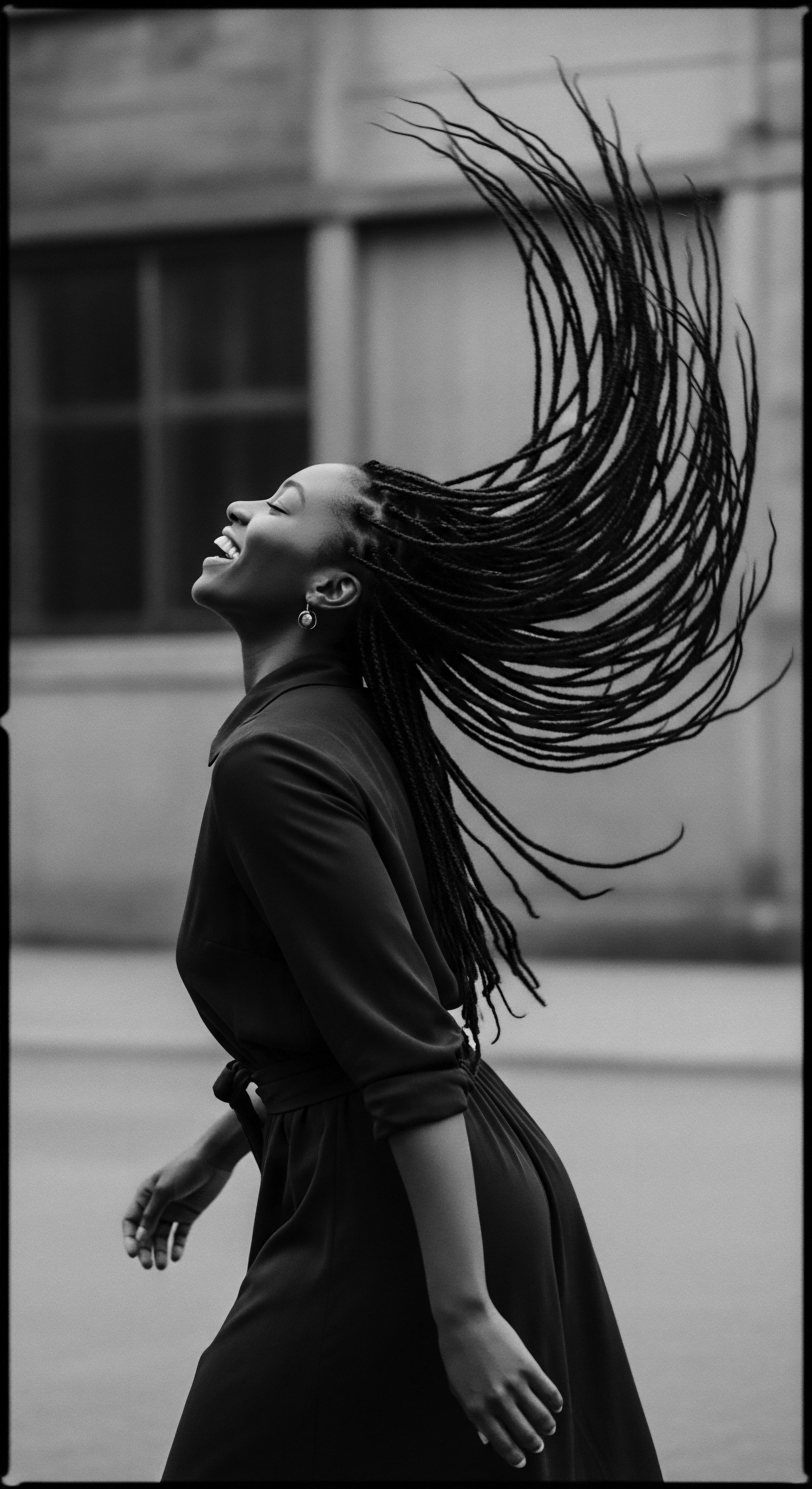
Fundamentals
The Natural Scalp Balm, at its foundational interpretation, represents a concentrated, usually semi-solid or solid, preparation designed to bestow targeted care upon the scalp. It differs from liquid oils or serums by its inherently denser consistency, often achieved through a carefully balanced combination of plant butters, waxes, and botanical oils. The intention behind its creation is multifaceted ❉ to provide deep moisture, to soothe, to protect, and to nourish the delicate skin of the scalp, which, beneath the canopy of textured hair, often requires specialized attention.
Consider the scalp not merely as a surface from which hair emerges, but as a living ecosystem, a foundational terrain demanding reverence. For those whose hair carries the intricate spirals, coils, and waves that define Black and mixed-race lineages, this terrain faces particular environmental and structural considerations. The unique architecture of textured hair, with its propensity for dryness and vulnerability to breakage along its bends, often means that the natural oils produced by the scalp struggle to traverse the full length of the hair shaft.
This inherent characteristic often leaves the scalp itself exposed and sometimes parched, longing for external support. The Natural Scalp Balm steps into this space as a restorative touch, a gentle guardian.
Its simple definition often points to its composition ❉ a blend of naturally derived ingredients, free from synthetic fragrances, harsh chemicals, or artificial dyes. This commitment to the elemental reflects an ancestral understanding of botanicals—a recognition that nature, in her profound generosity, offers remedies for our physical and spiritual well-being. The selection of ingredients is therefore purposeful, each chosen for its inherent capacity to bring balance and comfort to the scalp, echoing practices that predate modern formulations by millennia.

Ancestral Echoes in Elemental Care
The very concept of a scalp balm, though often articulated in contemporary terms, possesses a lineage stretching back to the earliest known human civilizations. Long before laboratories and factories, our forebears understood the necessity of protecting the scalp from environmental stressors and nurturing its vitality. They turned to the earth’s bounty ❉ rich plant oils rendered from seeds, protective waxes from bees, and therapeutic extracts from roots and leaves. These were combined, often through intuitive wisdom passed down through oral traditions, to create poultices, unguents, and pomades.
For communities whose heritage threads through the African continent and its diaspora, the connection to such elemental care is particularly profound. The hair and scalp were never merely aesthetic concerns; they were vital expressions of identity, spirituality, and health. The preparation of these early balms was often a communal act, a ritual of care that bound families and generations together.
They were crafted not just for individual benefit but as a collective act of preservation, a testament to shared knowledge and an affirmation of identity. These preparations, in their simplest forms, were the direct ancestors of what we today term the Natural Scalp Balm.
A Natural Scalp Balm offers targeted care to the scalp, a foundational ecosystem for textured hair, through a dense blend of natural ingredients.
The materials chosen for these foundational balms were often locally sourced, reflecting the botanical diversity of a given region. In West Africa, shea butter, extracted from the nuts of the shea tree (Vitellaria paradoxa), stood as a revered staple. Its creamy texture and rich emollient properties made it ideal for both skin and scalp. In other regions, perhaps baobab oil, or even simpler animal fats infused with healing herbs, served a similar purpose.
The essence of the Natural Scalp Balm, therefore, can be understood as an unbroken lineage of human ingenuity, adapting to environments while consistently seeking to provide comfort and restoration to the scalp. It is a humble, yet powerful, testament to enduring wisdom.

Intermediate
Moving beyond its fundamental definition, the Natural Scalp Balm begins to reveal its deeper purpose as a sophisticated agent of scalp wellness, particularly when viewed through the lens of textured hair heritage. Here, its meaning broadens from a simple topical application to a complex interplay of botanicals, tradition, and physiological responsiveness. An intermediate understanding acknowledges the balm’s capacity not only to soothe surface irritation but to create an optimal micro-environment for hair follicle health, a critical factor for the longevity and vitality of coily and curly strands.
The effectiveness of a natural balm for textured hair stems from its unique delivery system. Unlike liquid oils that might quickly dissipate or water-based products that evaporate, the balm’s semi-occlusive nature forms a gentle, protective layer. This layer serves several crucial functions ❉ it helps to prevent trans-epidermal water loss, thus maintaining scalp hydration; it shields the scalp from external aggressors; and it provides a sustained release of nourishing compounds directly to the skin and hair follicles. This sustained care is exceptionally beneficial for scalps prone to dryness, flakiness, or itchiness, conditions that are often exacerbated by the structural characteristics of textured hair and, historically, by environmental challenges faced by diasporic communities.

The Tender Thread ❉ Ingredients and Their Ancestral Resonance
The careful selection of ingredients within a Natural Scalp Balm speaks volumes about its efficacy and its connection to ancestral practices. Each component is a testament to generations of observation and experimentation, a living archive of botanical wisdom.
- Shea Butter (Vitellaria paradoxa) ❉ A cornerstone for textured hair care, its high concentration of fatty acids and vitamins (A, E, F) deeply conditions the scalp, offering emollient properties crucial for moisture retention. Its use traces back centuries in West African communities, where it was, and remains, a sacred balm for skin, hair, and spirit.
- Coconut Oil (Cocos nucifera) ❉ Valued for its penetrating abilities, it can help reduce protein loss in hair and soothe scalp conditions. Its presence in coastal African and Caribbean traditions as a versatile oil for body and hair underscores its historical significance.
- Jojoba Oil (Simmondsia chinensis) ❉ Remarkably similar to the natural sebum produced by the human scalp, making it an ideal regulator of oil production and a non-comedogenic moisturizer. While often associated with arid regions, its properties align with ancestral desires for balanced scalp health.
- Tea Tree Oil (Melaleuca alternifolia) ❉ Though primarily associated with Australia, the concept of potent botanical extracts with antiseptic and anti-fungal properties for scalp cleansing is deeply ingrained in many traditional African herbal medicine systems. Its modern use mirrors the ancestral quest for cleansing and healing.
These are but a few threads in a rich tapestry. The traditional preparation of these ingredients, often involving slow extraction processes and mindful blending, imbued the resulting balm with both physical efficacy and spiritual reverence. The act of applying such a balm became a ritual, a connection to the land, to the ancestors, and to the inherent power of the natural world. This historical perspective lends the Natural Scalp Balm a deeper significance, transforming it from a mere product into a conduit of enduring wisdom.
Intermediate understanding of Natural Scalp Balm recognizes its semi-occlusive nature, which sustains hydration and delivers nourishment, mirroring ancestral wisdom of botanical care.
The understanding of scalp conditions, too, held a different context in ancestral practices. Issues like dryness, flaking, or even minor irritations were often addressed not with harsh chemicals but with gentle, long-term applications of natural remedies. The balm provided a non-stripping alternative to harsh cleansing agents, allowing the scalp’s natural protective barrier to remain intact while still receiving therapeutic benefits.
This patient, consistent approach to care, deeply rooted in the rhythms of nature, stands in gentle contrast to the often fast-paced, quick-fix solutions sought in contemporary times. Yet, the wisdom embedded in these ancestral practices continues to guide the formulation and application of the most effective Natural Scalp Balms today.

Academic
The academic delineation of the Natural Scalp Balm transcends rudimentary definitions, delving into its profound dermatological, ethnobotanical, and socio-cultural dimensions, particularly within the specific historical and contemporary experiences of individuals with textured hair of Black and mixed-race descent. Here, the Natural Scalp Balm is not simply a product but an artifact of cultural sovereignty, a testament to ancestral ingenuity, and a subject ripe for rigorous scientific inquiry that often validates ancient wisdom. Its meaning, therefore, is multi-layered, encompassing elemental biology and the enduring legacy of human adaptation and resilience.
From a dermatological perspective, the Natural Scalp Balm functions as a critical emollient and occlusive agent, strategically formulated to address the inherent challenges faced by the scalp beneath textured hair. The unique elliptical shape of the hair follicle in individuals of African descent, leading to tightly coiled and spiraled hair shafts, inherently limits the effective distribution of sebum from the scalp along the entire hair strand. This anatomical reality frequently results in a scalp surface that is drier, more prone to desiccation, and consequently, more susceptible to conditions such as xerosis, pruritus, and various forms of dermatitis, including seborrheic dermatitis and irritant contact dermatitis.
A meticulously crafted Natural Scalp Balm, rich in biocompatible lipids and anti-inflammatory phytonutrients, provides a sustained lipid barrier, mitigating transepidermal water loss (TEWL) and restoring stratum corneum integrity. This creates a physiological environment conducive to optimal cellular function and reduced inflammatory responses, a fundamental biological objective often achieved through ancestral botanical compositions.

The Ancestral Pharmacopeia ❉ Ethnobotanical Insights and Validation
The academic understanding of Natural Scalp Balm compels an examination of its ethnobotanical roots, recognizing that many of its constituent ingredients have been revered for their therapeutic properties for millennia within African and diasporic communities. This ancestral pharmacopeia, transmitted across generations, represents an invaluable body of practical knowledge, increasingly validated by modern scientific research. Consider the compelling case of Jamaican Black Castor Oil (JBCO).
Derived from the seeds of Ricinus communis, its unique processing method—involving roasting the beans, grinding them, boiling them in water, and then pressing the oil—produces a darker, ash-infused oil. This specific method of preparation, rather than cold-pressing, is believed to enhance its therapeutic properties and distinguishes it culturally.
Ethnobotanical accounts and historical records underscore JBCO’s preeminent role in Caribbean and African-American hair care traditions as a potent remedy for scalp health, hair growth stimulation, and overall hair vitality. Contemporary scientific investigation, while still nascent in fully elucidating all mechanisms, has begun to corroborate some of these long-held beliefs. Ricinoleic acid, the primary fatty acid in castor oil, possesses documented anti-inflammatory and analgesic properties. Research, such as that by Marwat et al.
(2013), explores the traditional uses of various plants, including Ricinus communis, for dermatological conditions and hair growth, aligning with the empirical observations passed down through oral traditions within the diaspora. This specific historical example vividly illustrates how ancestral practices, often dismissed as folklore, contain a sophisticated understanding of plant chemistry and its application for specific physiological outcomes related to scalp and hair health. The very existence of JBCO, therefore, is a profound testament to the resilience and intellectual prowess of enslaved Africans and their descendants, who adapted ancestral knowledge to new environments and continued to cultivate healing traditions.
| Traditional Practice/Ingredient Shea Butter (Vitellaria paradoxa) |
| Ancestral Application for Scalp Used as a rich emollient to protect, moisturize, and soothe dry, irritated scalps; applied to prevent flaking. |
| Modern Scientific Alignment/Properties Rich in oleic and stearic fatty acids; exhibits anti-inflammatory properties (Adu-Amankwah et al. 2018). Forms a semi-occlusive barrier reducing transepidermal water loss. |
| Traditional Practice/Ingredient Jamaican Black Castor Oil (JBCO) |
| Ancestral Application for Scalp Applied to stimulate hair growth, treat scalp infections, and reduce inflammation; often warmed and massaged into the scalp. |
| Modern Scientific Alignment/Properties High ricinoleic acid content, known for its anti-inflammatory, antimicrobial, and analgesic properties. Traditional ash infusion may enhance alkalinity and penetration (Marwat et al. 2013). |
| Traditional Practice/Ingredient African Black Soap (Alata Samina) |
| Ancestral Application for Scalp Used as a gentle, purifying cleanser for scalp and hair, often applied in a diluted paste to address flakiness and itching. |
| Modern Scientific Alignment/Properties Derived from plantain skins and cocoa pods, rich in saponins and antioxidants; traditional production yields potassium hydroxide, a gentle cleansing agent that avoids harsh stripping (Adu-Amankwah et al. 2018). |
| Traditional Practice/Ingredient Chebe Powder (Croton zambesicus) |
| Ancestral Application for Scalp While primarily for hair strength, traditional application often involves mixing with oils/butters and applying near scalp to support strong roots and length retention. |
| Modern Scientific Alignment/Properties Contains alkaloids and saponins; research suggests it helps improve hair elasticity and reduces breakage, indirectly supporting scalp health by preventing traction-induced issues. |
| Traditional Practice/Ingredient This table illustrates the deep connection between ancestral African and diasporic hair care wisdom and contemporary dermatological science, affirming the efficacy of heritage practices for scalp well-being. |
The application methodology of these balms, often involving gentle massage and deliberate sectioning of hair, also holds academic interest. This practice enhances blood circulation to the scalp, promoting nutrient delivery to hair follicles, and evenly distributes the therapeutic compounds. This ritualistic approach further reinforces the psychological well-being associated with self-care, particularly significant for communities where hair has historically been a site of both oppression and resistance. The act of nurturing the scalp with these ancestral balms can be interpreted as a reclamation of agency and a profound affirmation of identity.

Scalp Care as Cultural Sovereignty ❉ Identity and Resistance
Beyond the physiological, the Natural Scalp Balm holds immense significance within the academic discourse on cultural identity and resistance, particularly within the Black diaspora. The hair and scalp, for centuries, have been battlegrounds where dominant cultural norms imposed standards of beauty that often negated the intrinsic textures of Black hair. Practices of “taming” or altering natural hair were often linked to socio-economic mobility and assimilation. In this context, the deliberate choice to embrace and nurture one’s natural texture, beginning with the health of the scalp, becomes an act of cultural sovereignty.
The academic meaning of Natural Scalp Balm reveals its role as an artifact of cultural sovereignty, a testament to ancestral ingenuity, and a subject ripe for rigorous scientific inquiry validating ancient wisdom.
The Natural Scalp Balm, therefore, becomes a symbol of this reclamation. Its use signifies a conscious return to ancestral practices, an honoring of indigenous knowledge systems that prioritize holistic well-being over imposed cosmetic ideals. It speaks to a collective awakening, where the care of textured hair, beginning at its very root—the scalp—is intertwined with a broader movement of self-acceptance, racial pride, and the celebration of heritage.
Academically, this transition reflects a decolonization of beauty standards, positioning traditional hair care practices, including the creation and application of scalp balms, as integral components of Black aesthetic theory and cultural studies. It underscores the profound interconnectedness of physical care, identity formation, and socio-political agency, demonstrating that the seemingly simple act of applying a balm to the scalp is, in fact, a deeply meaningful and historically resonant gesture.
Moreover, the contemporary resurgence of interest in Natural Scalp Balms, often formulated with ingredients like those used ancestrally, represents a market-driven validation of heritage. This shift encourages ethno-pharmacological research, documenting and preserving traditional plant knowledge, ensuring that the wisdom embedded in these practices is not lost but rather understood and propagated through modern scientific lenses, while always acknowledging its origins. The academic lens allows us to appreciate the Natural Scalp Balm as a dynamic entity—a bridge between ancient wisdom and contemporary science, continually evolving yet eternally rooted in the profound care for textured hair and its inherent legacy.

Reflection on the Heritage of Natural Scalp Balm
As we traverse the myriad meanings and applications of the Natural Scalp Balm, a deeper understanding emerges ❉ it is more than a mere topical preparation. It is a living echo, a tangible connection to the ingenuity and resilience embedded within generations of textured hair care. From the simplest foundational definition to its complex academic interpretations, the balm persistently points to an unbroken chain of ancestral wisdom, a tender, persistent dialogue between humanity and the botanical world. The legacy of scalp care, particularly within Black and mixed-race communities, speaks volumes of adaptability, self-preservation, and an enduring reverence for the hair as a profound marker of self and lineage.
The journey of the Natural Scalp Balm is, in essence, the journey of the strand itself—a journey from elemental biology to the unbound helix of identity and future possibility. It reminds us that every application of a natural balm, every soothing massage into the scalp, is an act of historical communion. It is a quiet honoring of those who, through hardship and ingenuity, preserved knowledge of healing plants and protective practices.
It is a recognition that the care of our hair, from its very roots, is a continuous act of self-love, cultural affirmation, and generational continuity. The balm, in its very simplicity, holds stories, traditions, and the profound, soulful wisdom of our collective hair heritage.

References
- Adu-Amankwah, B. Asiedu-Larbi, D. & Owusu-Mensah, N. (2018). Traditional African Black Soap ❉ A Review. Journal of Pharmacy and Alternative Medicine, 7(2), 27-35.
- Marwat, S. K. Fazal-ur-Rehman, M. & Anwar, M. A. (2013). Ethnobotanical Studies of Plants Used for Hair Care in Pakistan. Journal of Medicinal Plants Research, 7(12), 705-714.
- Obasi, P. A. (2012). African Cultural Practices and Their Impact on Hair and Scalp. International Journal of Trichology, 4(1), 1-4.
- Powell, C. L. (2013). Hair Story ❉ Untangling the Roots of Black Hair in America. St. Martin’s Press.
- Byrd, A. D. & Tharps, L. (2001). Hair Story ❉ Untangling the Roots of Black Hair in America. St. Martin’s Press.
- Sparrow, N. B. (2019). The Science of Black Hair ❉ A Comprehensive Guide to Textured Hair. Sagers Press.
- Bankole, K. A. (2004). African Americans and the Attainment of Beauty ❉ The Cultural Aesthetic of Hair and Skin. African American Review, 38(4), 693-706.
- Akerele, O. (1993). African Traditional Medicine and Its Role in Health Care Delivery. World Health Forum, 14(3), 295-301.
- Kittles, R. A. & Royal, C. D. (2003). Race, Genetics, and Health ❉ An Evolutionary Perspective. Howard University Press.
- Hunter, M. (2011). Buying Beauty ❉ The Ethnic Beauty Industry’s Pursuit of the Black Consumer. University of North Carolina Press.
